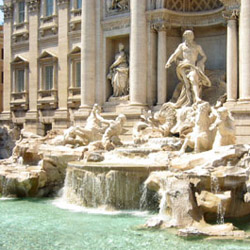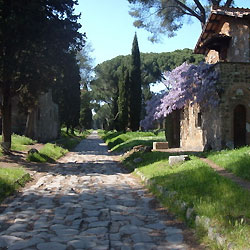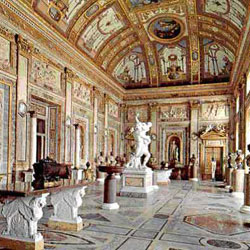Rome Tours
Monumental Rome | Archaeological | St. Peter Basilica, the Vatican and Sistine Chapel | Trevi Fountain, the Catacombs, Appian Way, Borghese Gallery
Trevi Fountain, the Catacombs, Appian Way, Borghese Gallery
The capital of italy is probably the most visited city in the world. Whilst, arguably, for the Italians Rome is primarily the political centre of the nation, for others it is its wealth of architectural and artistic treasures which makes it a truly remarkable and unforgettable city. The numerous museums, monuments and churches, not to mention the archeological sites, represent a cultural heritage so vast that a whole lifetime would not be sufficient to explore it in its entirety.
This is why if you come to Roma...non basta una vita per visitarla, is not enough a life time to visit the Eternal City.
Suggested day tour of Rome with the visit of Catacombs of St, Sebastian, Appian Way, the Borghese Gallery and Trevi Foutain, the service is driver/guided and is individually personalized.
Monumental Rome | Archaeological | St. Peter Basilica, the Vatican and Sistine Chapel | Trevi Fountain, the Catacombs, Appian Way, Borghese Gallery
Trevi Fountain, the Catacombs, Appian Way, Borghese Gallery
The capital of italy is probably the most visited city in the world. Whilst, arguably, for the Italians Rome is primarily the political centre of the nation, for others it is its wealth of architectural and artistic treasures which makes it a truly remarkable and unforgettable city. The numerous museums, monuments and churches, not to mention the archeological sites, represent a cultural heritage so vast that a whole lifetime would not be sufficient to explore it in its entirety.
This is why if you come to Roma...non basta una vita per visitarla, is not enough a life time to visit the Eternal City.
Suggested day tour of Rome with the visit of Catacombs of St, Sebastian, Appian Way, the Borghese Gallery and Trevi Foutain, the service is driver/guided and is individually personalized.
| Trevi Fountain. There is hardly a tourist who visits Rome without stopping to admire the majesty of the Trevi Fountain, a monument known throughout the world, where to throw a coin in the waters is said to guarantee the owner's return to the "eternal city". Based on the design of Nicola Salvi, the Trevi Fountain takes the sea for its inspiration with a huge shell drawn by sea horses in their turn led by tritons and the statue of the Ocean by Pietro Bracci, whilst in niches on either side are the statues of Abundance and Wealth by Filippo Della Valle. Trevi Fountain is the perfect example of the marriage of baroque sculpture and architecture, an aquatic masterpiece which becomes even more captivating at night when it is illuminated. In the immediate vicinity of the Trevi Fountain one finds the Colonna gallery, the Doria Pamphilj Gallery, the Church of St Ignazio, the Church of the Apostles and the Church of St Marcello al Corso and the archaeological area of the vicus Caprarius- underground Rome. |
 |
| Catacomb of St. Sebastian. The Catacombs of Rome are ancient catacombs, or underground burial places under or near Rome, of which there are at least forty, some discovered only in recent decades. Though most famous for Christian burials, they include pagan and Jewish burials, either in separate catacombs or mixed together. They began in the 2nd century, as much as a response to overcrowding and shortage of land as they were to satisfy the need for persecuted Christians to bury their dead secretly. The soft volcanic tofo rock under Rome is highly suitable for tunnelling, as it is softer when first exposed to air, hardening afterwards. Many have kilometers of tunnels, in up to four stories (or layers). The Catholic catacombs are extremely important for the art history of early Christian art, as they contain the great majority of examples from before about 400 CE, in frescos and sculture. The Jewish catacombs are similarly important for the study of Jewish art at this period. To visit is the Catacomb of St, Sebastian, which the tomb of St. Sebastian is in the basilica, but his original resting place was in the catacombs underneath it. From the reign of Valerian to the reign of Constantine, the bodies of St, Peter and St, Paul were hidden in the catacombs, which were dug from tufa, a soft volcanic rock. The big church was built in the 4th century. The tunnels here, if stretched out, would reach a length of 11km (6 2/3 miles). In the tunnels and mausoleums are mosaics and graffiti, along with many other pagan and Christian objects from centuries even before the time of Constantine. Though the catacombs themselves are fascinating, the tour here is one of the shortest and least satisfying of all the catacomb visits. |
 |
| The Appian Way. The Appian Way (Via Appia) was one of the earliest and strategically most important Roman roads of the ancient republic. It connected Rome to Brindisi, Apulia, in southeast Italy. Its importance is indicated by its common name, recorded by Statius. Appia teritur regina longarum viarum "the Appian way is commonly said to be the queen of the long roads". The road is named after Appio Cludio Cieco, the Roman censor who began and completed the first section as a military road to the south in 312 BC during the Samnite Wars. The main part of the Appian Way was started and finished in 312 BC. The road began as a leveled dirt road upon which small stones and mortar were laid. Upon this gravel was laid, which was finally topped with tight fitting, and interlocking stones to provide a flat surface. Some of the stones were said to fit so well that you could not slide a knife into the cracks.The road was crested in the middle (for water runoff) and had ditches on either side of the road which were protected by retaining walls. The road began in the Roman Forum, passed through the Servian Wall at the porta capena, went through a cutting in the clivus Martis, and left the city. For this stretch of the road, the builders used the via Latina.The building of the Aurelian Wall centuries later required the placing of another gate, the Porta Appia. Outside of Rome the new via Appia went through well-to-do suburbs along the via Norba, the ancient track to the Albans hills ( Today Albano), where Norba was situated. The road at the time was a via glarea, a gravel road. The Romans built a high-quality road, with layers of cemented stone over a layer of small stones, crowned, drainage ditches on either side, low retaining walls on sunken portions, and dirt pathways for sidewalks. The via Appia is believed to have been the first Roman road to feature the use of lime cement. The materials were volcanic rock. The surface was said to have been so smooth that you could not distinguish the joints. The Roman section still exists and is lined with monuments of all periods, although the cement has eroded out of the joints, leaving a very rough surface. |
 |
| Villa Borghese and the Gallery. For those wishing to relax, stroll through the gardens, take part in sport or immerse themselves in internationally famous art works, Villa Borghese is the site in Rome to head for. Its long avenues provide the ideal environment in which to skate, rollerblade, skateboard, mountain bike, or simply enjoy walking. Rowing boats can be hired for trips on the lake. In the area next to the Piazza del Popolo, il Pincio, one can enjoy the splendid panorama over the Vatican and Mont Mario. At the height of the Galoppatoio visitors can gaze out over the entire historic center of Rome from an electric hot air balloon. Villa Borghese is also a center of culture, with a gallery housing art works of great importance, such as the sculptures by Antonio Canova and canvases by Caravaggio. In the part of the park in front of the Piazza di Siena is the museum dedicated to the sculptor and composer Pietro Canonica. Among the events hosted at Villa Borghese is the famous annual equestrian competition. |
 |